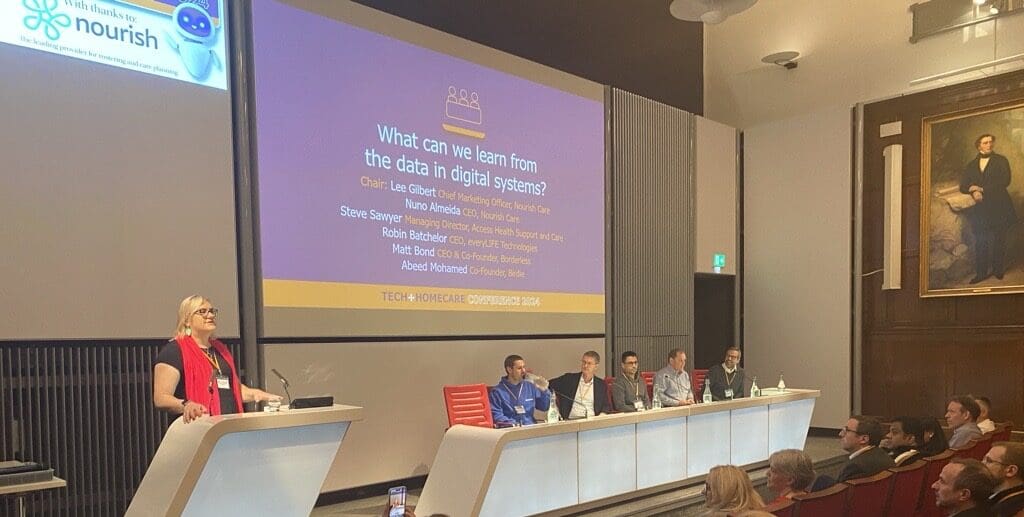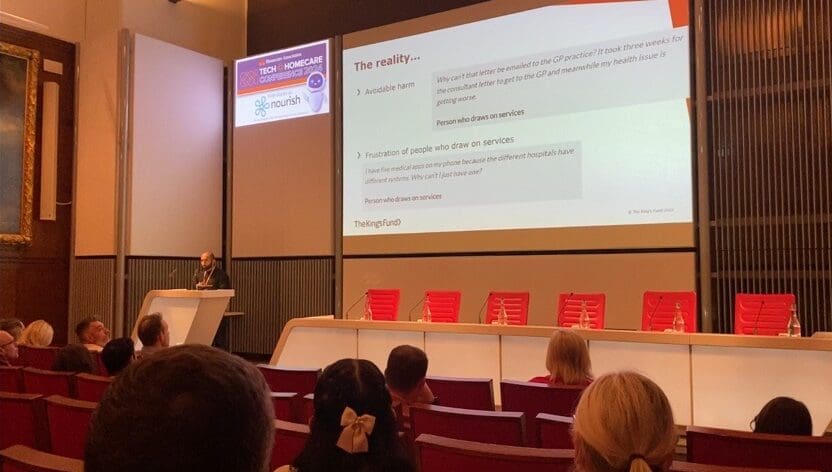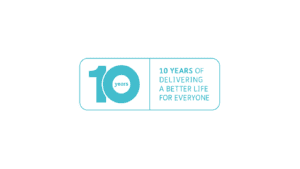When Wes Streeting announced his three key shifts for the National Health Service (NHS) at the Labour Party Conference at the end of September social care’s ears were burning. A move from analogue to digital, hospital to community and sickness to prevention is a move towards care. Clearly social care has a big part to play in the future of the NHS. And technology plays a crucial role in the future of social care. When applied correctly digital solutions empower us to improve both efficiency and outcomes. Which offers care technology a central role in the government’s ongoing attempts to stage a digital revolution in health and care. We all know the why, given social care’s enduring challenges. It is uncovering the precise, who, what, when, and how of the matter that remains something of a mystery.
On the Road and On the Trail
We recently headline sponsored the Home Care Association (HCA)’s Tech & Homecare conference. A day of insights, inquisition and understanding for leading home care providers and technology suppliers. On the day our CMO, Lee Gilbert, hosted a panel featuring a who’s who of digital rostering and AI suppliers discussing data, while The King’s Fund’s Pritesh Mistry joined HCA’s CEO Dr Jane Townson OBE to ask, ‘How can technology solutions help move care closer to home?’. The latter a conversation underpinned by the recently published, Nourish Care sponsored, study exploring ‘The reality of, and potential for, digitally enabled care in the community’. Reflecting the collaborative spirit of co-development that defines modern, outstanding care, these conversations detailed a variety of ongoing efforts to move social care from analogue to digital. Their success, their missteps, and the road still ahead.
The HCA Panel
Chair: Lee Gilbert, CMO, Nourish
Nuno Almeida, CEO, Nourish
Steve Sawyer, Managing Director, Access Group
Robin Batchelor, CEO, everyLife Technologies
Matthew Bond, CEO, Borderless
Abeed Mohammed, Co-founder, Birdie

Data, Status Report
There is already a wealth of positive examples of technology improving care quality. Providers applied digital solutions to a selection of the challenges they face. Both The King’s Fund research, and each of the panellists, presented their own positive instances. Pritesh detailed several different, key, areas that are already befitting from digital solutions, such as communication, care co-ordination and personalisation. Dr Townson added to this during their conversation, highlighting some Local Authority’s recent adoption of ‘magic notes’ as an example of technology changing people’s lives.
The panel built upon these cases with a specific focus on utilising existing data in systems. Matt Bond shared how Borderless share and aggregate data to pass benefits to individual people by finding the gaps in your existing service. The other four panellists all pointed to the efficiency their respective rostering platforms bring to care providers. When Robin Batchelor brought attention to the current inflection point in care technology it resonated around the room. Nuno Almeida agreed, “We’ve spent 14 years building the foundations. It’s not rocket science; the rocket science lies in your ability to react to needs.”
People at the Heart of Care Technology
That is the crux of the matter, when we move from analogue to digital, we have to retain our focus on people’s needs. The ability to react to these needs is defined by our ability to engage with them. One of the biggest fears about moving from analogue to digital is based in the apprehension of losing the human touch that has always guided health and care in the UK. A fact reflected in two of the recommendations from the King’s Fund’s research. The need to ‘Shift culture to embrace the public’s digital capability’ and ‘Support staff to embed tech in their roles’. Neither of which are groundbreaking discoveries, but do require fresh ideas to address. Such as Scottish Care’s Care Technologist role. We know the potential of carers, their adaptability and commitment to any idea that can improve outcomes for their community.



What we need to do is make engaging with, and championing, care technology a simpler process. Which is not something that can be done overnight. “Asking people what is important to them is the biggest gap in our data,” admitted Nuno during the panel. “But this is also a big opportunity for us, asking, ‘What will really make a difference?’” The more we can involve people in the design process, the more ‘frontline’ feedback we can apply to our development. This co-production keeps people at the heart of care technology, which is crucial as we move to put technology at the heart of care.



Building Benefits for the Right People
Dr Townson concisely summarised this issue during her talk with Pritesh. ‘Technology for technology’s sake is not progress’. Innovation cannot be disruption in care, the standard approach for technology entering a new sector. The responsibilities are too great. We have to understand the barriers and develop enablers for adoption in the workforce and communities they support. Any one software solution aiming to promote wrap around care and support needs to ask itself a simple question. ‘How will the care providers work alongside our tech?’

Pritesh highlighted the need for this focus in his research with The King’s Fund. One of the recommendations from this research underlines the need to ‘develop strategies for co-developing digitally enabled services’. Specifically raising the point that developing a strategy for co-development and patient-led service design will help to direct digital service development and strategy. While this suggestion calls for action from ICSs, ICPs, the NHS and the Department of Health and Social Care (DHSC), it speaks to all digital suppliers and providers in social care. The move from analogue to digital in care must involve people at every step, or it is sure to get lost.
Analogue to Digital at a Walk, Crawl and Run
Nuno spoke about the need to ‘crawl, walk, then run, to get to data quality’. A process that rings true for all forms of digital technology. When The King’s Fund recommends ‘A national vision to guide local decisions’ it is not calling for a direct mandate. It is asking for a personalisable framework. ‘A guiding national vision, with local flexibility as to how it is achieved. One that will help to align the efforts of technology innovators, health and care providers, and leaders designing improved community-based services.’
The HCA’s conference was an example of just that endeavour. A selection of leaders, creators and providers sharing experiences and ambitions to help shape the future of care as we move from analogue to digital. One based in the commitment to collaboration that makes care the beating heart of our communities. After all, if you’re going to solve a mystery machine, it’s best to do it with a gang.








